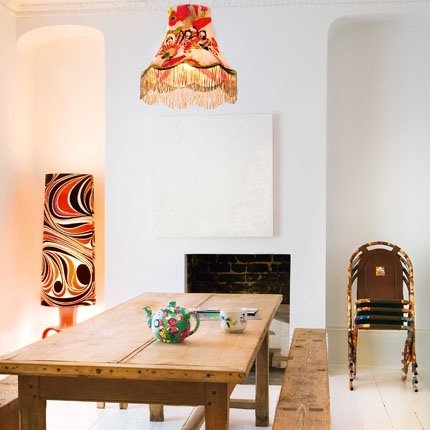 In the London home of designer Lisa Whatmough, the dining room's white walls and floors and minimal table and benches allow Lisa's work — the fringed hanging lamp, the teapot covered in a Liberty pattern, and the chairs — to shine. In the corner, more colour is introduced with an Italian lamp covered in a vintage 1970s psychedelic fabric. Over the fireplace hangs artwork by Lisa, made of a white floral pattern on a white background.
In the London home of designer Lisa Whatmough, the dining room's white walls and floors and minimal table and benches allow Lisa's work — the fringed hanging lamp, the teapot covered in a Liberty pattern, and the chairs — to shine. In the corner, more colour is introduced with an Italian lamp covered in a vintage 1970s psychedelic fabric. Over the fireplace hangs artwork by Lisa, made of a white floral pattern on a white background. On the other side of the dining room, Lisa has created a colourful corner with a Victorian armchair covered in a quilt of toile de Jouy, silk and damask fabric, a luminous ball covered with 1920s French tissue paper, and a lamp that once belonged to her mother, made into a kitsch bouquet of flowers. On the wall, a mirror has been covered with Japanese fabric as the final touch to the bright patchwork atmosphere.
On the other side of the dining room, Lisa has created a colourful corner with a Victorian armchair covered in a quilt of toile de Jouy, silk and damask fabric, a luminous ball covered with 1920s French tissue paper, and a lamp that once belonged to her mother, made into a kitsch bouquet of flowers. On the wall, a mirror has been covered with Japanese fabric as the final touch to the bright patchwork atmosphere. For the kitchen, Lisa kept things simple with a minimal and functional stainless steel work area. A note of colour is introduced with the folding chair and the shelf above the stove, which displays a custom collection of patchwork teapots.
For the kitchen, Lisa kept things simple with a minimal and functional stainless steel work area. A note of colour is introduced with the folding chair and the shelf above the stove, which displays a custom collection of patchwork teapots. In a corner of the house, artwork by Lisa hangs over the square fireplace. The floor lamp has been completely covered in Japanese fabric by Lisa, while the old chair she found has a slightly changed version of its original covering. The candelabra has been covered in fabric dating from 1920, while the French silk covering the stool is by Gainsborough.
In a corner of the house, artwork by Lisa hangs over the square fireplace. The floor lamp has been completely covered in Japanese fabric by Lisa, while the old chair she found has a slightly changed version of its original covering. The candelabra has been covered in fabric dating from 1920, while the French silk covering the stool is by Gainsborough. In the bedroom the large gilt wood-framed mirror reflects the walls painted in Lamp Grey from Farrow & Ball, the black-painted French Empire bed, the painted wood venetian blinds, cotton canvas curtains (originally from an old butcher shop) and a blackboard painted by Lisa.
In the bedroom the large gilt wood-framed mirror reflects the walls painted in Lamp Grey from Farrow & Ball, the black-painted French Empire bed, the painted wood venetian blinds, cotton canvas curtains (originally from an old butcher shop) and a blackboard painted by Lisa.
Designer Lisa Whatmough's fantastic London home is a showcase for her imaginative reinvention of the traditional craft of patchwork, using the technique to cover everything from chairs to picture frames and teapots. Lisa began working in patchwork four years ago, when she discovered and fell in love with a beautiful 19th century silk. But, she had such difficulties finding more old silk in large enough quantities for her projects that she began to quilt as a way of using what she did have. From that starting point Lisa has gone on to include Japanese fabric, French fabrics from the early twentieth century, velvet, vintage Liberty, quilted satin, and modern chintz in all colours and patterns. As she herself says, "I have no limits!" In her home, the neutral background of white floors and walls (with the exception of a black accent wall here and there) allows her vivid creations to glow. Via Marie Claire Maison, with a (very) loose translation by me.